Menu
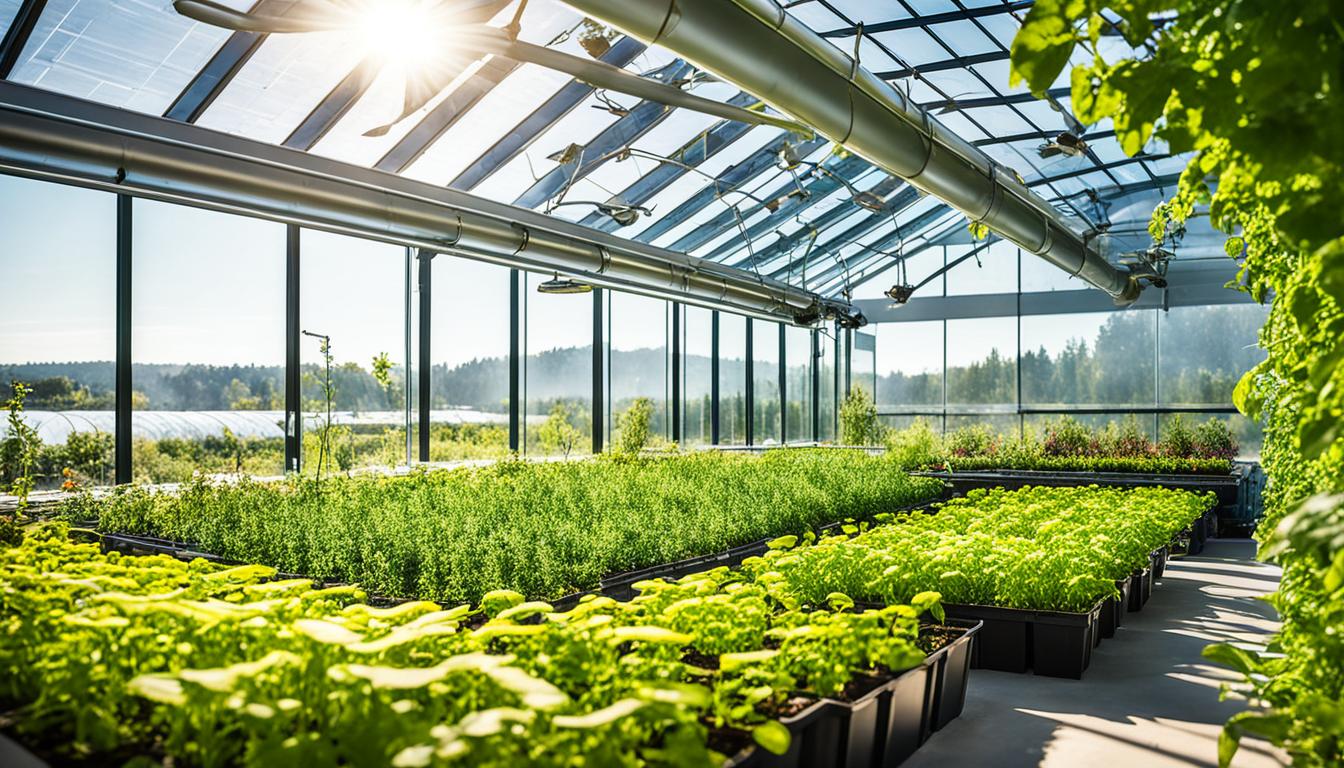
Agriculture is a big part of the world’s greenhouse gas emissions, about a quarter. This shows why we need to focus on sustainable farming. Eco-friendly horticulture in greenhouses is growing in popularity. It merges organic farming with greenhouse growing. This creates a perfect environment for growing food naturally and without chemicals.
Organic greenhouse farming is more than a trend. It’s about creating healthy food while protecting the earth. Greenhouses keep plants safe from bad weather, pests, and diseases. This helps us grow food without using harmful chemicals. We focus on keeping the soil healthy too. We do this by adding natural things to the soil and keeping an eye on its nutrients.
In these greenhouses, we don’t use bad chemicals to control pests. We use natural ways to keep the crops healthy, like keeping a close watch on water and the greenhouse’s climate. This way of farming not only meets our needs for healthy food but also looks out for the earth’s future. It protects the environment for the generations to come.
Organic greenhouse farming combines ancient farming techniques with modern technology. It uses special greenhouses to grow crops without using harsh chemicals. This approach aims to protect the environment and biodiversity.
Organic greenhouse farming means growing plants in a special house that’s good for the environment. It avoids using harmful pesticides, synthetic fertilisers, and radiation. This way of farming helps produce healthy food all year, no matter the weather. It also protects the plants by keeping a natural balance, which means fewer pests and healthier plants.
Over time, organic greenhouse farming has improved by finding better ways to control pests and make fertilisers. Many farmers choose these methods to keep the environment safe and meet the demand for organic food. Thanks to organisations like the USDA’s National Organic Program, people can trust that food from these greenhouses is truly organic.
“In 2017, nearly 15,000 acres in North America were dedicated to ‘food crops grown under protection,’ reflecting the growing interest and adoption of greenhouse techniques in organic agriculture.”
Places like Mexico are also jumping on board, going from 15,000 to 57,000 acres in just two years. This shows how organic greenhouse farming is becoming a big part of sustainable agriculture around the world.
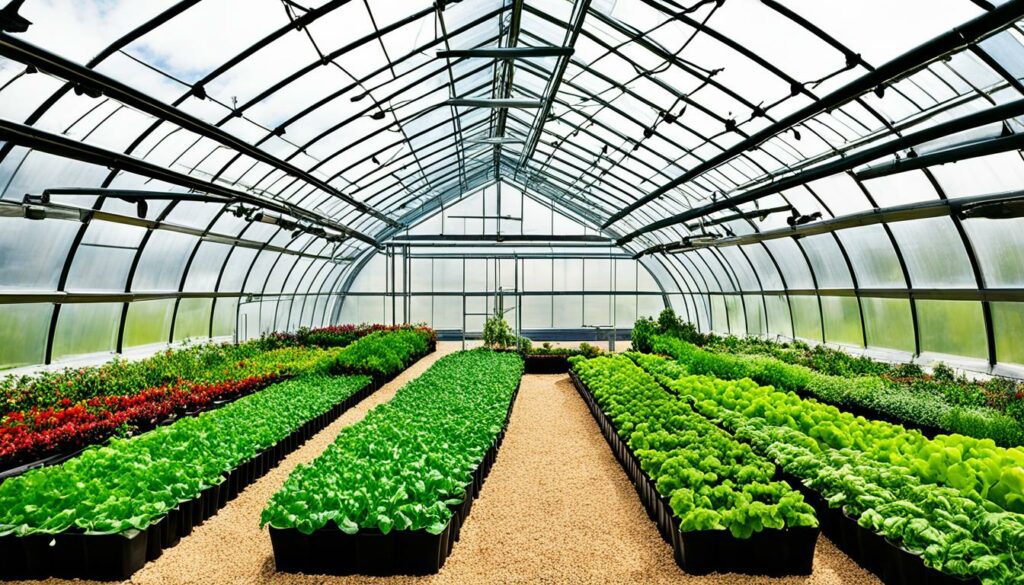
Organic greenhouse farming brings a range of advantages. These include helping the environment, bringing in money, and offering healthy food. It uses green technology to farm sustainably, making both the plants and the world better.
Organic greenhouse farming is good for the environment. It supports a variety of life and keeps pollution low by not using artificial pesticides. In Canada, for example, it protects crops from pests, diseases, and outdoor pollution, which boosts their health and productivity.
Greenhouses also save water with systems like the Vialux UV disinfection. This makes farming even more sustainable. Green technology in agriculture helps reduce harm to nature further.
Greenhouse farming has strong economic benefits. It’s flexible, allowing for good yields even in poor soil. Greenhouses with special systems for CO2, light, and heat increase the quality and amount of crops.
Thanks to these advantages, businesses can sell their organic products at a premium. This has resulted in a 50% sales increase in Canada from 2008 to 2012, reaching $3 billion.
Consumers benefit greatly from organic greenhouse farming. The absence of synthetic chemicals in food reduces health risks from pesticides. In Canada, over 58% of people buy organic weekly, showing the strong interest in health-friendly foods.
Greenhouses manage climate, water use, and farm techniques closely, ensuring top-notch organic produce. This makes the food not only organic but also of high quality, benefiting people’s health.
| Environmental Impact | Economic Gains | Health Benefits |
|---|---|---|
| Promotes biodiversity | Year-round production | Free from synthetic chemicals |
| Reduces pollution | Premium pricing | Lowers risk of pesticide-related health issues |
| Enhances sustainability | Increased profitability | High-quality produce |
| Recyclable water systems | Market differentiation | Robust consumer demand |
Today, greenhouses are key in organic farming, boosting sustainability and efficiency. They use eco-friendly materials and smart design to support organic farming and save energy.
It’s important to use sustainable materials in building greenhouses. Materials like recycled steel or aluminium lessen harm to the environment.
Replacing glass with polycarbonate panels saves energy and makes the structure last longer. The design should let in lots of natural light. This is done by placing windows and arranging the roof well.
Greenhouses can also use the earth’s heat and the sun to stay warm. This way, they don’t rely as much on fossil fuels. Using these methods helps keep the right conditions for growing without wasting resources.
Making greenhouses energy efficient is a big deal for the planet and for saving money. It’s about how it’s built and operated. Good insulation keeps the place warm in winter and not too hot in summer.
Adding solar panels and wind turbines can power the greenhouse. Smart systems control the climate, which is good for plants and saving resources.
| Greenhouse Features | Advantages | Examples |
|---|---|---|
| Sustainable Construction Materials | Reduced environmental impact, durability | Recycled steel, polycarbonate panels |
| Geothermal Heating | Renewable energy use, lower heating costs | Geothermal heat pumps |
| Solar Panels | Renewable energy, lower electricity costs | Photovoltaic systems |
| Advanced Climate Control | Optimised growing conditions, less resource wastage | Automated temperature, humidity adjustment |
With these strategies, greenhouses become sustainable and efficient. This not only helps the Earth but also produces high-quality organic food. It meets what consumers and standards require.
Managing the soil well is key in an organic greenhouse. We focus on soil health to build a strong farming environment. This supports both productivity and longevity in our growing practices.
We use organic soil amendments like compost and cover crops. These help keep our soil fertile and well-structured. Using such materials means the soil is healthy and full of the right kind of life. Farms that have the Baystate Organic Certifiers’ seal meet strict USDA standards. This ensures they are truly organic.
Testing and keeping an eye on the soil constantly is crucial. By checking the soil regularly, we follow important measurements. This includes pH levels and the soil’s ability to hold nutrients. Knowing this helps us pick the right materials to keep the soil healthy and productive.
For us, maintaining soil health is the main target. This focus helps our soil do its job well, like recycling nutrients and stopping erosion. We also keep to organic rules, such as not using forbidden substances on our soil. This is key for our organic certification and shows our firm commitment to organic farming values.
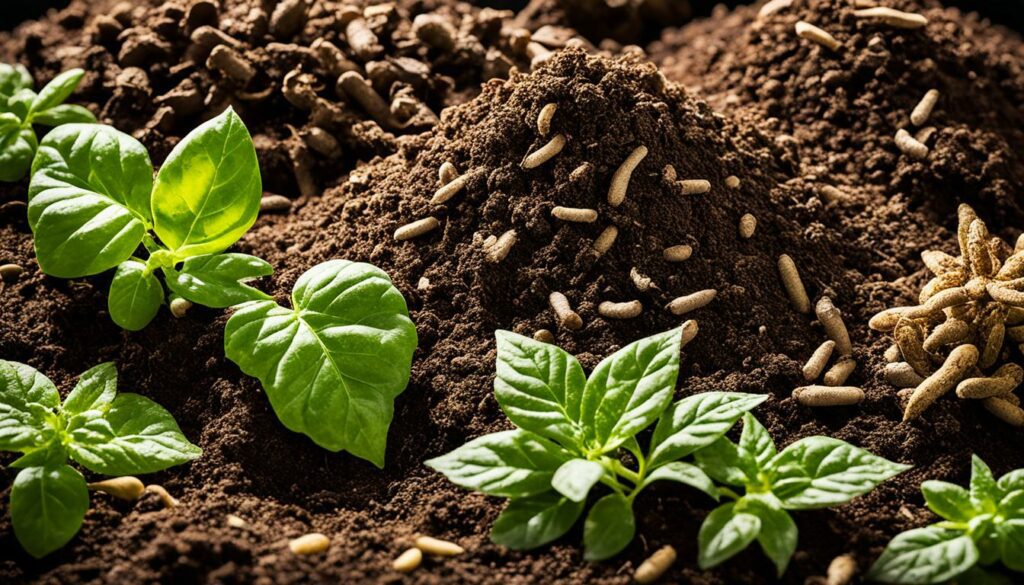
| Soil Property | Importance in Organic Farming |
|---|---|
| Soil Structure | Ensures adequate air and water flow, benefiting root growth. |
| Soil pH | Influences nutrient availability and microbial activity. |
| Cation Exchange Capacity (CEC) | Measures soil’s ability to hold and exchange nutrients effectively. |
| Soil Organic Matter | Enhances nutrient cycling, moisture retention, and structure. |
It’s vital for greenhouse crops to get nourished right. Organic fertilizers play a huge part in this. They are key for eco-friendly soil care while promoting plant growth.
There is a wide range of organic fertilizers to choose from. You can pick from compost, aged manure, and organic-approved granular or liquid versions. Compost of high quality gets quite warm, between 131ºF and 170ºF. This kills off bad bugs and weed seeds, meeting high standards. It’s made from things like animal manure, leftover crops, and grass.
For fertilizing before planting, there’s fish meal, soybean meal, and kelp meal. These meals offer different nutrients and how fast they get released. Vermicompost is becoming popular. It’s full of nutrients and the plants can use them easily.
How you apply fertilizer matters a lot. You want nutrients to seep into the soil slowly, just right for plants. This stops waste and harm to the environment. You can apply fertilizer in different ways, like broadcasting or side-dressing. The aim is always to help plants grow in a green way.
Adding compost at 30-40% can help potting soil hold water and not be too heavy. This way, plant roots can grow well. The U.S. greenhouse vegetable industry uses these methods a lot. They meet the big demand for organic food.
Keeping pests in check in organic greenhouses blends natural and beneficial insect methods. This way is called biological pest control. It creates a healthier environment without using man-made chemicals. Rules from the USDA and the National Organic Program say farmers should work to control pests using friendly ways and when needed, okayed materials.
Organic pest control uses physical methods to cut down on pests. This can mean bringing in bug-eating insects or making homes for them. Or it might be using natural controls like traps and repellents. Pulling weeds by hand or with help from animals is another method. So is using flame or electric tools. To fight plant disease, farmers might change how they plant or water. They could also use specific natural or mineral mixtures.
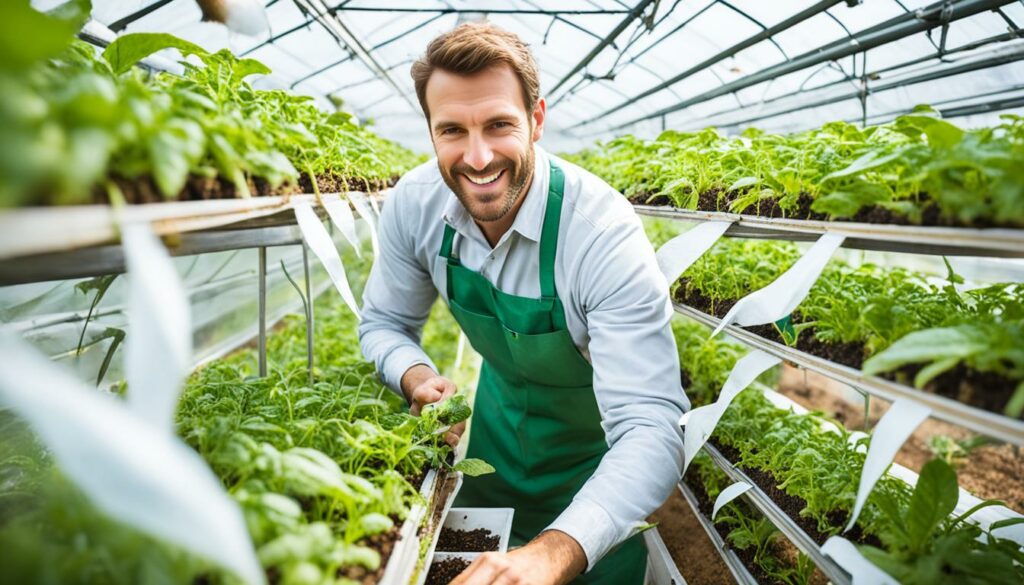
In organic greenhouses, good bugs are key to keeping things in balance. Bugs like ladybugs and lacewings help control the bad ones. For example, in Massachusetts, a low-cost method using good bugs cut down on whiteflies in poinsettias. It cost only ten cents per plant. Many companies sell these helpful bugs, like IPM Laboratories and Syngenta Bioline.
In warmer greenhouses, using netted walls can help keep out bad bugs. They also keep the helpful bugs inside, making organic pest control stronger. These greenhouses also make special food to keep the good bugs strong, like brine shrimp or pollen. This helps farming stay green and renewable.
Greenhouses create ideal conditions for sustainable farming. They act as small worlds where crop rotation and companion planting work well. These methods help farms stay healthy and keep the soil in good shape.
Crop rotation stops the soil from getting tired. It does this by not letting the land rely too much on one kind of plant. By switching what’s grown, the earth stays rich and healthy.
As an example, planting garlic and tomatoes in different spots each year keeps the soil strong. It also stops some bugs and diseases from making a permanent home.
This way is good not only in greenhouses but also in big garden beds. It copies how nature works by mixing up what grows where. This mixture of crops helps keep the earth and plants happy, leading to better harvests.
Companion plants are like good friends for your crops. For instance, marigolds stop pests from bothering tomatoes. And legumes, such as peas and beans, help soil by adding important nutrients.
Mixing different plants together can use garden space well. It also helps keep away bad bugs and spread nutrients evenly.
But, you need to think ahead when planning. For example, fennel shouldn’t be near some other plants. And it’s best not to grow the same kind of crop in one place for too long.
This kind of careful planting is more than just farming. It makes for a farm that works well on its own, like a natural system.
We start our organic greenhouse journey with top-notch seedlings and the best plant sourcing. Being certified organic means our seeds are grown without harmful chemicals or GMOs. This choice is key for growing strong, healthy plants naturally.
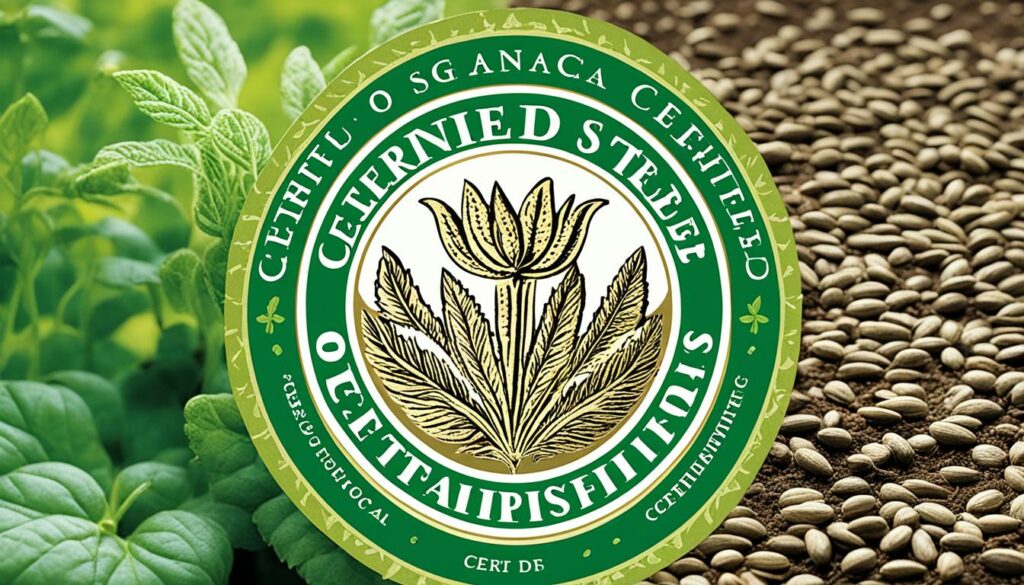
We team up with trusted suppliers like High Mowing Organic Seeds and Johnny’s Selected Seeds. They provide a wide range of organic seeds, tailored for different climates and needs. This careful selection keeps our greenhouse operations strong from the start.
Choosing the right seeds is crucial for our organic greenhouse. With organic seed certification, we know our seeds are safe and can fight off pests and diseases well. Better seeds mean better growth, healthier plants, and more crops. Starting with quality seeds is a big part of why our greenhouse is sustainable and productive.
Effective water management is key in organic greenhouses. It makes sure plants get enough water. It also helps save water in farming, which is good for the environment. This way, water is used well and irrigation works better.
Drip irrigation systems play a vital role in using water wisely. They give plants water right at their roots. This stops water from being wasted. The system can be adjusted to fit each plant’s specific water needs. For example, big plants might need more water than smaller ones. It’s important to check the system often. If there are any leaks, a lot of water can be lost. Just one drop per second could waste over 113 gallons each month. In-pot drip systems are a top choice for organic greenhouses for how well they work.
Rainwater harvesting is great for the environment. It fits perfectly with organic farming. Greenhouses can collect rain off their roofs. This water is kept in tanks for when it’s needed. A greenhouse with an acre of space can collect about 27,100 gallons from just 1 inch of rain. This cuts down the need for other water sources. It’s also a cheap way to water plants. The setup includes tanks, roof washers, and diverters to make sure water is used well.
| Technique | Benefit |
|---|---|
| Drip Irrigation | Enhances irrigation efficiency by delivering water directly to plant roots |
| Rainwater Harvesting | Promotes sustainable water use by utilising naturally collected water |
Using these methods helps us save water in farming. They match organic practices and make our greenhouses more sustainable. By focusing on using water wisely, we help organic farming last for a long time.
Keeping organic greenhouses at the proper climate is key. It helps the crops grow well and stay healthy. We control things like temperature, humidity, and airflow to make the perfect plant environment.
Good ventilation in greenhouses stops heat and humidity from building up. This can stress plants and make them sick. Greenhouses with IoT tech manage airflow well. They keep moisture levels low and the temperature stable. Smart greenhouse systems spot problems like leaf colour changes or bugs early. This helps us keep the plants healthy.
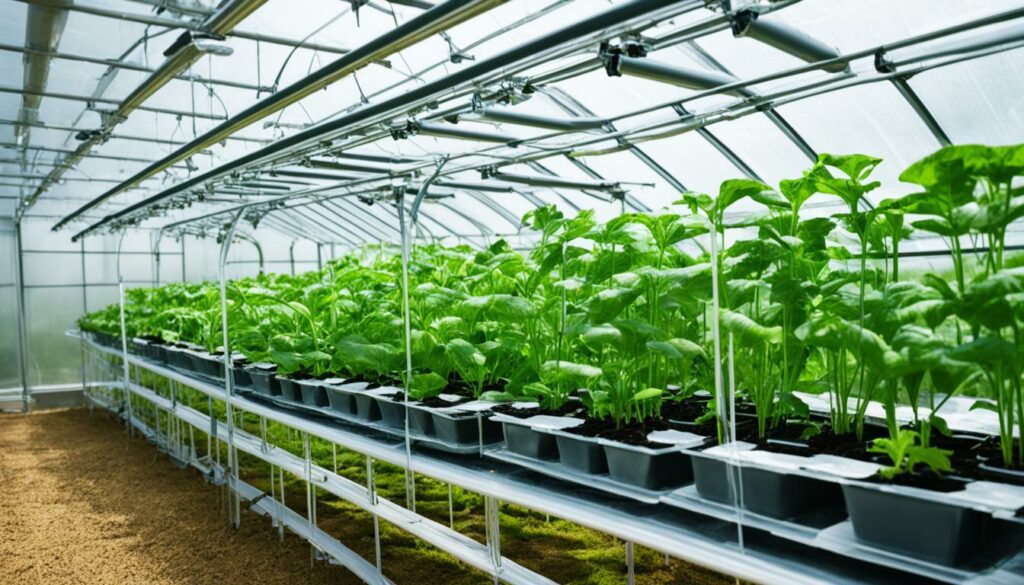
Getting the right temperature and humidity is crucial. Greenhouses that can be high-tech maintain the perfect climate for crops, boosting yields. They use less energy, cooling places like the Mediterranean. They use about 100,000 kWh of energy per hectare each year. These systems also keep the humidity from 60% to 80%. This makes sure our crops are in the best conditions.
| Region | Average Coverage (hectares) | Cooling Energy Consumption (kWh/ha/year) |
|---|---|---|
| Temperate Regions | 4.7 million | N/A |
| Mediterranean Region | 364,000 | 100,000 |
| Tropical/Subtropical Regions | 156,000 | N/A |
| MENA Regions | 13,000 | Varies |
| Gulf Cooperation Countries | 71,297 | 10.43 – 14.67 kWh/m² |
Advancing with technology helps us use resources better. It makes our crops better and helps the environment. We make sure our horticulture is sustainable and eco-friendly with these modern systems.
Effective pest management in organic greenhouses uses IPM. It mixes biological controls with cultural practices. This keeps the ecosystem in balance. Here, we will look into the main parts of these techniques.
In organic farming, IPM’s heart lies in biological controls. This means using good bugs to beat the bad ones. Using insects like ladybirds, or predators, and honey bees for spreading good fungi, helps keep things in check. Growers also watch out for pests with yellow cards, checking about 3-4 cards in every 1,000 square feet. Being always on the lookout and inspecting crops often is key. This stops bad bugs and diseases from causing big problems.
Another big piece of IPM is about how we grow things. This includes keeping plants at good distances and always keeping the area clean. It’s also about knowing when to take action if pests appear too much. By breaking down big areas into smaller ones, management becomes easier. And keeping hands clean and checking roots helps stop problems before they start. At the end of each season, looking back at what worked and what didn’t, helps plan for the next year.
Using both bugs and smart farming techniques together makes IPM work well. It keeps pests under control without damaging the environment. Also, it makes the food healthier and meets the high standards of the supermarkets.
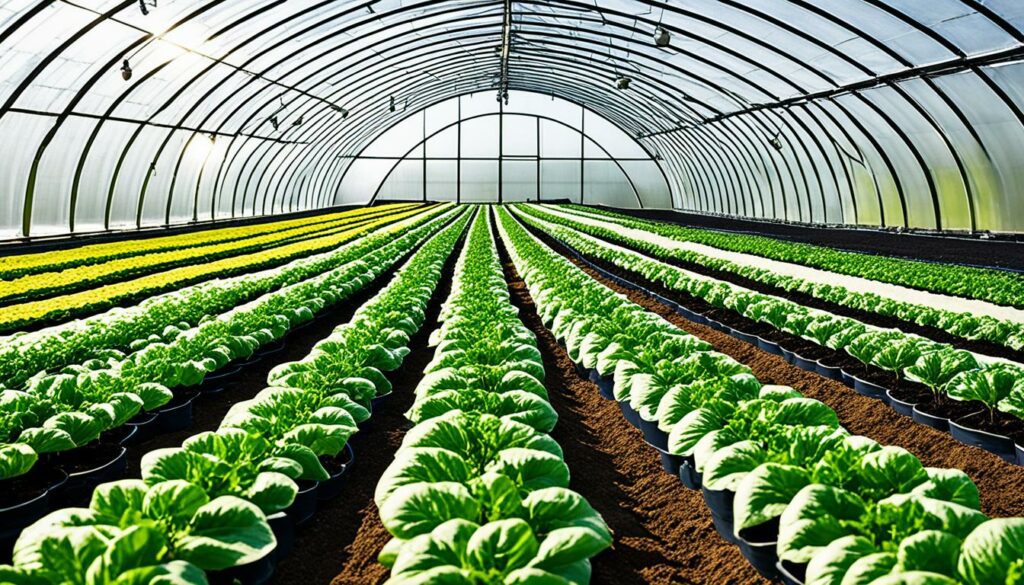
Getting organic certification is tough but important for greenhouse crops. The USDA’s National Organic Program sets the rules. If a farm makes more than $5,000 a year in organic sales, it must follow these rules. To get certified, farms need to show they meet high standards for being organic.
Start by applying to a certifying agent, like Baystate Organic Certifiers in the Northeast US. You’ll need to show lots of info on how you grow your crops. This includes how you care for the soil, where your seeds come from, and how you handle pests. You have to use organic or untreated seeds for greenhouse crops. And your soil can’t have any banned substances for at least three years before you apply.
Next, there are farm inspections. Groups like UMass Extension will check if your farm meets the organic standards. They will make sure your soil mix and any lumber touching the soil are not treated with bad stuff. You can’t use fertilisers or substances that are not allowed in organic farming.
The USDA National Organic Program is very detailed about what it means to be organic. It focuses on how crops are grown. You must use practices that keep the soil healthy, like changing what you grow each season and adding things back into the soil. You also have to follow strict rules on when and how you use manure.
After you’re certified, you have to keep up with your farm’s inputs, like pesticides and fertilisers. The OMRI makes sure these inputs are okay to use in organic farming. It’s all about managing pests and diseases without harming the environment. This means using natural ways, like letting helpful bugs eat the harmful ones, and pulling out weeds by hand.
Work with groups like NOFA and SARE and get help from ATTRA to know about the latest in organic farming. These partnerships keep you connected to the best ways to grow organic. They also help you meet the high expectations of people who care about the environment.
If you do not follow the USDA’s organic rules and claim your products are organic, you could face big fines. This shows how serious it is to follow the organic standards and be honest about your products.
For success in premium organic markets, smart marketing is key. With the rise of greenhouse farming, finding the best market channels and setting good prices is critical. This can mean the difference between success and just getting by.
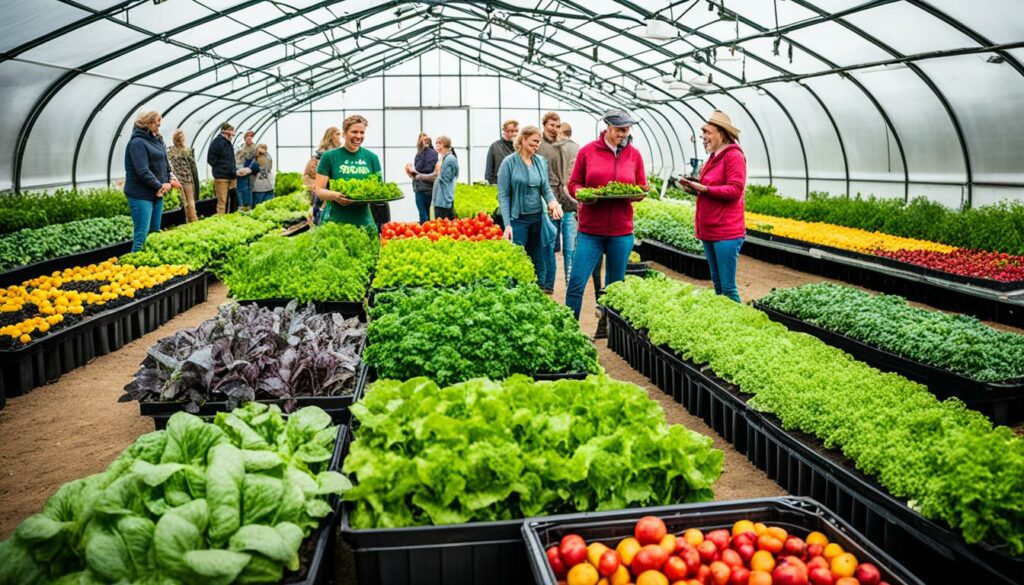
It’s key to know what customers want in top organic markets. In Canada, from 2008 to 2012, organic product sales increased from $2 billion to $3 billion. Over 58% of Canadians now buy organic weekly. This shows a strong demand for organic greenhouse produce, available at farmer’s markets, health food stores, and directly from the farm.
Greenhouses let farmers grow all year, no matter the weather. They protect crops from pests, diseases, and bad weather. This gives customers the quality and consistency they seek in organic food. Greenhouses also let farmers control the climate, water, and nutrients. This means organic produce can meet the strict demands of competitive markets.
To charge higher prices, organic greenhouse farmers need a strong brand. They must teach consumers about the benefits of their methods. These include no harmful pesticides and the use of advanced farming technologies. It’s important to show that greenhouse farming is safe and results in top-quality organic food.
Prices in premium markets should show the value of sustainable farming. For example, greenhouses that use special lights and heating can produce better crops. This justifies the higher prices. Pricing strategies should also consider demand, costs, and what consumers are willing to pay for organic food.
Getting top prices also means following certification rules. If organic sales are over $5,000 a year, USDA certification is needed. This keeps farmers honest and builds trust with consumers. It allows them to charge more for their organic goods.
Using social media, events, and partnering with respected organic brands can boost visibility. It can also increase customer loyalty. In a fierce market, these efforts make greenhouse-grown organic food stand out.
In short, understanding the market and aiming for good pricing is key for organic greenhouse farmers. Investing in sustainable practices and getting certified helps charge higher prices. It keeps the organic business growing and profitable.
Organic greenhouse farming is key to a sustainable future. It mixes controlled farming with organic methods. This helps the planet and our health. In North America, by 2017, almost 15,000 acres grew food safely. Hoophouses and greenhouses show how we can farm with care.
Mexico shows how big this can be, using about 60% of its farms for greenhouses in 2019. This was 57,000 acres for just vegetables. In the United States, the USDA found 715 acres were devoted to organic vegetables and mushrooms. Places like California, Pennsylvania, and Colorado lead in growing organic tomatoes, covering 152 acres.
Organic farming isn’t just good for us, it’s good for the ground. Studies show it boosts soil health and keeps it productive for long. But, making things grow in greenhouses costs a lot in work and energy. This pushes growers to find new, cheaper ways to run.
Looking at the big picture, organic farming creates less harm to the planet. Studies have pointed out big differences in how much pollution is made. So, by choosing organic, we’re making a better future. It’s a way to feed more people without hurting our planet.
Organic greenhouse farming blends the benefits of a greenhouse with organic farming methods. It shuns chemical use, focusing on maintaining the soil’s health. This approach ensures the food grown is both healthy and kind to the environment.
Good soil health means the ground is full of the nutrients that plants need. By staying away from harsh chemicals and adding natural elements, the soil stays rich. This is essential for the plants to grow well over time.
It helps nature by increasing the variety of life, cutting down on pollution, and using earth-friendly farming ways. This type of farming keeps the ecosystem in balance by using natural ways to control pests and save resources.
Organic greenhouse buildings use eco-friendly materials and smart designs to save energy. They can be permanent with sophisticated heating and cooling systems. Or, they can be simpler, using less energy, which are called hoophouses.
Some organic fertilisers are compost, aged manure, and special granular or liquid ones. It’s important to use them in a way that slowly gives the plants the nutrients they need. This protects the environment from harm.
In these greenhouses, pests are controlled naturally. This means using good bugs like ladybugs and setting up physical barriers. The goal is to keep the ecosystem balanced by not using harmful chemicals.
By rotating crops and planting friends next to each other, the ground stays healthy and pests find it hard to survive. For example, marigolds can keep pests away and growing legumes helps improve the soil with nitrogen.
Beginning with the best organic seeds or seedlings is crucial for growing successful, organic crops. These seeds come from certified sources that follow strict organic rules. This is important for meeting quality standards.
To use water well and keep things green, greenhouses rely on drip systems and saving rainwater. These practices help save water and make sure plants get just what they need. This is good for the environment and the crops.
The right climate inside the greenhouse means plants can grow all year in a healthy way. With automated systems, farmers can keep everything just right. This also helps to keep diseases away from the plants.
IPM mixes biological and garden care methods to look after plants in a natural way. The goal is to use as few chemicals as possible. This approach keeps plants safe and helps the whole garden stay in balance.”
For crops to be called organic, a respected organisation must certify them. They need to follow the US Department of Agriculture’s organic rules. This includes regular checks and making sure they farm in an organic way.
Selling at places that value organic food, like special markets or eco shops, is key. A strong focus on their high organic quality helps farmers charge more. And it makes their brand stand out in a busy market.”